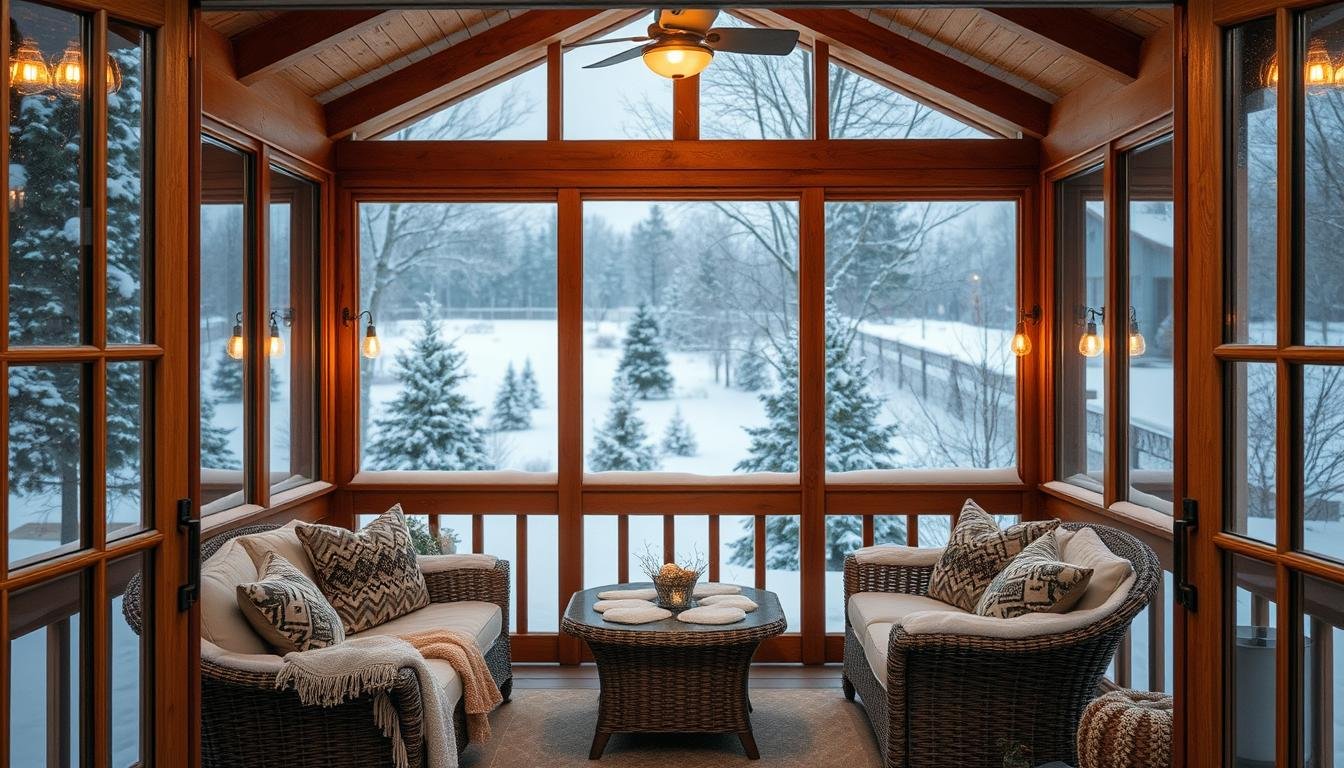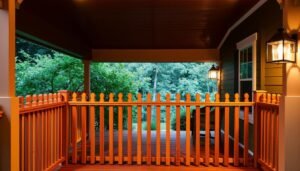As winter approaches, you may wish to enjoy your porch without the chill. Enclosing your porch lets you admire the outdoors from the warmth of your home. It keeps out snow, rain, bugs, and pollen too. By choosing materials like AKON’s clear porch tarps or vinyl panels, your porch stays warm without losing the view. Make your porch a warm spot this winter and get the most out of the season.
Key Takeaways
- Enclosing your porch helps maintain a cozy outdoor space throughout winter.
- Clear vinyl walls and tarps are affordable choices for temporary enclosures.
- Choosing the right materials, such as AKON’s clear porch tarps, ensures insulation and visibility.
- Proper planning and tools are essential for a successful winter porch enclosure.
- Enclosing your porch protects against snow, rain, pests, and pollen, while still letting in light.
Understand the Benefits of Enclosing Your Porch
Enclosing your porch has lots of perks, making an outside space cozy indoors. It creates an extra room you can enjoy any time of the year. It’s a cozy spot that’s shielded from bad weather, perfect for chilling or having fun.
The perks during winter are especially great. An enclosed porch keeps you warm and lets you enjoy winter sights without feeling cold. It keeps the space warm and protects your furniture from harsh weather, making it easier to take care of your things.
It can also make your home worth more. People looking to buy a house often like enclosed porches because they look good and add something special to the house. Installing screens that you can pull back lets fresh air in but keeps bugs and bad weather out. These screens match your home perfectly because they are made just for your space.
Enclosed porches also make your home safer. They add an extra layer that helps prevent break-ins. You can also add a type of screen that blocks people from seeing in but lets you look out. This improves privacy and helps keep your home warm or cool.
For ease, choose motorized screens like the H4500 or H4800. They’re simple to use, making it easy to host guests any time of the year. Plus, if you decide to sell your house, an enclosed porch can attract buyers quickly. Homeowners can get back 70-80% of what they spend on the enclosure when they sell their home.
Choose the Right Enclosure Material
Picking the best enclosure materials is key to a long-lasting and cozy porch. Options like clear vinyl tarps and panels are not just budget-friendly, but they’re also simple to set up. This makes them a great mix of safety and ease.
| Material | Durability | Aesthetic Appeal | Protection Level | Cost Range |
|---|---|---|---|---|
| Vinyl Porch Enclosures | High | Moderate | Excellent | $5,000 – $15,000 |
| Sunrooms | Very High | High | Exceptional | $20,000 – $50,000+ |
| Screened Enclosures | Moderate | Moderate | Limited | $5,000 – $10,000 |
| Polycarbonate Roofing | High | Low | Good | $3,000 – $8,000 |
Three-season and four-season rooms have their own benefits. Three-season rooms are best from spring to fall. They are less costly but don’t control the climate well. Four-season rooms are pricier but good all year. They have great insulation and save energy with features like double-pane glass.
Aluminum frames in your porch last long with little upkeep. Clear vinyl tarps guard well against weather. Screened enclosures are perfect for places with mild weather. They provide flexibility and are easy to put in.
Finding the best material for your porch depends on your needs, weather, and budget. Whether you go for vinyl enclosures or another option, making a smart choice can really make your home better and more valuable.
Plan the Layout and Design of Your Enclosure
Planning your porch layout well is key to making your outdoor space useful and pretty. Think about how much sun it gets, which way the wind blows, and if it looks right with your house. Good planning not only gives you more space to enjoy but can make it nicer to be outside in colder weather.
First, look at how sunny your porch gets all day. A sunny porch needs less electric light, saving energy and money. If it faces south, it gets the most sun, keeping it warmer and cutting heating costs by up to 30% in the winter.
Wind direction matters too. Your porch should block the main winds to stay cozy. Using double-glazed glass can keep it about 10-15 degrees warmer than without it.
For great porch designs, think about adding skylights and big windows. They bring in more light and connect inside with outside, making it feel bigger. Adding things like outdoor fireplaces can also make it up to 25% warmer, letting you use the porch all year.
Make sure your porch is easy to use. Set up your furniture so people can move around easily. Lightweight and strong wicker furniture is both comfortable and practical. Using clear vinyl or heavy plastic sheets can keep it warm affordably, costing about $1 to $3 per square foot.
Pick the right materials to make your winter porch last and stay warm. Polycarbonate sheets are super tough, and PVC panels keep the heat in. Having good air flow can stop too much condensation, which keeps away mold and keeps the air fresh.
| Material | Benefits | Cost Range |
|---|---|---|
| Double-Glazed Glass | Maintains an indoor temperature 10-15 degrees warmer; enhances sunlight exposure | $30-$60 per square foot |
| Polycarbonate Sheets | Impact-resistant, durable, lifespan of 10-20 years | $20-$40 per square foot |
| Clear Vinyl | Retains up to 90% of heat; cost-effective | $1-$3 per square foot |
Think about hiring pros to avoid mistakes that happen in about 20% of DIY projects. With careful planning and the right work, your winter porch can be a warm, useful spot that makes your home worth more and more comfortable.
Gather Necessary Tools and Materials
Starting your DIY porch enclosure project? Make sure you have all the needed tools and materials first. Having the right tools makes the building process smoother and quicker. This means you can enjoy your new space faster, without unwanted delays.
You will need a measuring tape and a level for accurate measurements and alignment. A circular saw and a jigsaw are must-haves for cutting materials. Don’t forget to include screws, nails, and wood for framing in your list.
Clear plastic sheets or vinyl are good choices for enclosing a porch. They can warm up the area by up to 10°F more than outside. To keep the warmth in, heavy, weather-resistant curtains cut heat loss by about 25%. A staple gun with the right staples is needed to secure these sheets or vinyl.
To enhance your toolkit, add a drill with different bits, a utility knife, and a hammer. The cost for porch screens varies, usually between $100 and $400, based on size and material. Make sure you have enough fiberglass or aluminum screening material.
Getting all your materials ready before you start saves time. It also means you don’t have to stop working to get something you forgot. Being prepared helps you build your porch enclosure without interruptions.
Besides gathering your tools and materials, it’s smart to look into porch enclosure guides. These guides highlight the importance of planning and safety. For deeper insight, check out this comprehensive DIY porch enclosure guide.
Remember, a well-done porch enclosure can boost your home’s value by as much as 15%. It’s a project that adds enjoyment and value to your home.
Step-by-Step Instructions for Porch Enclosure
Starting a DIY porch enclosure project brings both comfort and an added home feature, especially in winter. Begin with these key steps to make your outdoor space a warm part of your home.
- Set Up the Frame: Pick lumber that resists decay and bugs, like cedar or redwood. The size depends on your porch, but a 14 x 16 feet area usually needs pressure-treated 6x6s for support.
- Install Insulation: Good insulation keeps the warmth in. Use fiberglass or foam board to cut heating costs by up to 30%. Don’t forget to insulate both the floor and walls completely.
- Fit Windows and Clear Vinyl: Choose between double-pane windows or vinyl. Double-pane windows can cut cold by 50% better than single-pane. Vinyl should be durable, 30 or 40-gauge, with 54 inches typical width. For a 20-foot opening, you’ll need about 14 yards of material.
- Sealing: Use weatherstripping or caulk against drafts to save 10-20% on energy. Secure every seam well, using grommets 18 inches apart for strength.
- Install Heating Solutions: Add an electric heater to warm up by an extra 10-15 degrees Fahrenheit. Radiant floor heating is another way to keep it cozy.
As you work through the porch enclosure steps, you’ll add both looks and function. Adding details like wainscoting and trim can even boost your home’s value by up to 10%. Finish off with a spot for hot drinks to make winter meet-ups cozy.
These steps offer a clear path to how to enclose a porch effectively. Whether it’s your first project or you’re seasoned in DIY, this guide helps you create a warm, welcoming space for the winter.
Decorate Your Enclosed Porch for Winter
Make your enclosed porch a warm hideaway with smart décor and accessories. Start with cozy textiles like thick rugs and soft pillows. These not only add comfort but also keep the place warm. With decorating enclosed porch, you create a spot for great times and quiet moments.
Using different lights is a top winter porch decor idea. Mix fairy lights, lanterns, and LED candles for a gentle, welcoming shine. This boosts the mood and keeps the porch lit on long, dark evenings.
Add snug seats and consider heaters to stay warm. Choose from propane, electric heaters, or chimineas. They add warmth and make the porch cozy for the winter.
Insulated curtains are great for cozy porch designs. They keep the heat in and can open for air, giving you warmth and freshness.
Here are some tips to mix beauty with practicality:
- Pick marine-grade stuff so it lasts in bad weather.
- Get weather-resistant zippers for extra safety.
- Use tough glass that doesn’t scratch easily to keep views clear.
- Decorate with fluffy blankets and holiday decor for added warmth.
With these winter porch decor ideas, you’ll have a welcoming and warm space. It’s about mixing style with usefulness, to make your porch a comfy refuge in winter.
| Decorating Tip | Benefit |
|---|---|
| Layered Lighting | Creates ambiance and improves visibility |
| Insulated Curtains | Retains heat while allowing ventilation |
| Warm Textiles | Enhances insulation and comfort |
| Durable Materials | Withstands harsh weather |
| Patio Heaters | Provides additional warmth |
Tips for Maintaining Your Enclosed Porch
Taking care of your enclosed porch is key to keeping it in good shape year-round. Make sure to clean materials like acrylic panels and vinyl to prevent damage. Regularly hosing down the enclosure and using mild soap on tough spots can help a lot.
It’s important to look for any signs of wear, particularly with the vinyl parts. Sun exposure can damage acrylic panels, making them bend and yellow. To prevent this, think about using tempered glass instead. It lasts longer and is safer, breaking into small pieces rather than sharp ones. Also, corrosion-resistant hardware can double the life of door and window fittings in places near the sea.
Check your porch’s sealing and insulation before winter starts. Using thermally broken glass can make your porch more energy-efficient, keeping it warmer. Make sure all locks work well to lower the chance of break-ins. These steps will help protect your porch and make it last longer while looking great.




